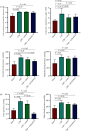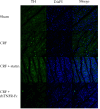Atorvastatin, etanercept and the nephrogenic cardiac sympathetic remodeling in chronic renal failure rats
- PMID: 38800544
- PMCID: PMC11112150
- DOI: 10.26599/1671-5411.2024.04.007
Atorvastatin, etanercept and the nephrogenic cardiac sympathetic remodeling in chronic renal failure rats
Abstract
Background: Chronic renal failure (CRF) patients are predisposed to arrhythmias, while the detailed mechanisms are unclear. We hypothesized the chronic inflammatory state of CRF patients may lead to cardiac sympathetic remodeling, increasing the incidence of ventricular arrhythmia (VA) and sudden cardiac death. And explored the role of atorvastatin and etanercept in this process.
Methods: A total of 48 rats were randomly divided into sham operation group (Sham group), CRF group, CRF + atorvastatin group (CRF + statin group), and CRF + etanercept group (CRF + rhTNFR-Fc group). Sympathetic nerve remodeling was assessed by immunofluorescence of growth-associated protein 43 (GAP-43) and tyrosine hydroxylase positive area fraction. Electrophysiological testing was performed to assess the incidence of VA by assessing the ventricular effective refractory period and ventricular fibrillation threshold. The levels of tumor necrosis factor-alpha (TNF-α) and interleukin-1beta were determined by Western blotting and enzyme-linked immunosorbent assay.
Results: Echocardiogram showed that compared with the Sham group, left ventricular end-systolic diameter and ventricular weight/body weight ratio were significantly higher in the CRF group. Hematoxylin-eosin and Masson staining indicated that myocardial fibers were broken, disordered, and fibrotic in the CRF group. Western blotting, enzyme-linked immunosorbent assay, immunofluorescence and electrophysiological examination suggested that compared with the Sham group, GAP-43 and TNF-α proteins were significantly upregulated, GAP-43 and tyrosine hydroxylase positive nerve fiber area was increased, and ventricular fibrillation threshold was significantly decreased in the CRF group. The above effects were inhibited in the CRF + statin group and the CRF + rhTNFR-Fc group.
Conclusions: In CRF rats, TNF-α was upregulated, cardiac sympathetic remodeling was more severe, and the nephrogenic cardiac sympathetic remodeling existed. Atorvastatin and etanercept could downregulate the expression of TNF-α or inhibit its activity, thus inhibited the above effects, and reduced the occurrence of VA and sudden cardiac death.
© 2024 JGC All rights reserved; www.jgc301.com.
Figures









Similar articles
-
Atorvastatin attenuates sympathetic hyperinnervation together with the augmentation of M2 macrophages in rats postmyocardial infarction.Cardiovasc Ther. 2016 Aug;34(4):234-44. doi: 10.1111/1755-5922.12193. Cardiovasc Ther. 2016. PMID: 27149420
-
Astaxanthin promotes M2 macrophages and attenuates cardiac remodeling after myocardial infarction by suppression inflammation in rats.Chin Med J (Engl). 2020 Aug 5;133(15):1786-1797. doi: 10.1097/CM9.0000000000000814. Chin Med J (Engl). 2020. PMID: 32701588 Free PMC article.
-
Phloretin ameliorates heart function after myocardial infarction via NLRP3/Caspase-1/IL-1β signaling.Biomed Pharmacother. 2023 Sep;165:115083. doi: 10.1016/j.biopha.2023.115083. Epub 2023 Jul 4. Biomed Pharmacother. 2023. PMID: 37413902
-
[Study on mechanisms and myocardial protective effect of Qishen Yiqi dropping pills on rats with myocardial infarction].Zhonghua Wei Zhong Bing Ji Jiu Yi Xue. 2017 Jun;29(6):501-505. doi: 10.3760/cma.j.issn.2095-4352.2017.06.005. Zhonghua Wei Zhong Bing Ji Jiu Yi Xue. 2017. PMID: 28625237 Chinese.
-
Sympathetic nerve sprouting, electrical remodeling and the mechanisms of sudden cardiac death.Cardiovasc Res. 2001 May;50(2):409-16. doi: 10.1016/s0008-6363(00)00308-4. Cardiovasc Res. 2001. PMID: 11334845 Review.
References
LinkOut - more resources
Full Text Sources
Miscellaneous
